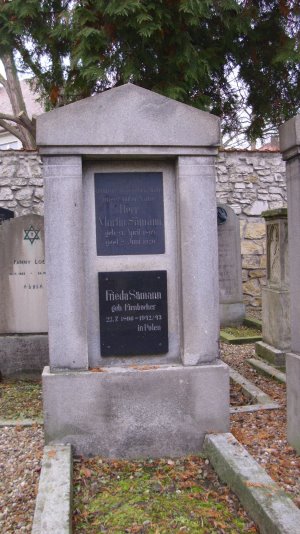|
||||||||||||
The Saemann´s --- family traces Martin Sämann, born in Suggenheim in 1894, married Frieda Firnbacher in 1922 and moved with her from Straubing to Regensburg. Their two children were both born in Regensburg: Ilse in 1923 and Heinz four years later in 1927. Martin, who came from a family of cattle dealers, made his living as a dealer of cattle and hops. Great misfortune, however, befell the family when Martin died in 1929 from the consequences of an injury he had suffered as a soldier in WWI. He is buried on the Jewish cemetery in the City Park of Regensburg. Consequently, Frieda Sämann had to ensure the livelihood of the family. With Eugen Jordan, she opened a cattle business in the Fröhliche-Türken-Straße 5. Business was thriving at the slaughterhouse, as Helmut Halter describes in his standard work on Regensburg during the Nazi era. That did, however, soon lead to antagonism and envy – as early as 1934, the so called „Reichsverband des nationalen Viehhandels“ demanded that the cattle dealers Sämann & Jordan be barred from entering the slaughterhouse. But Dr. Jakob Kolb, veterinarian and director of the slaughterhouse, was able to prevent this by arguing that there was no legal foundation for the claim. Eventually, the city’s Lord Mayor Schottenheim concurred with Kolb’s argument and turned down the Reichsverband’s application. |
||||||||||||
The attacks on the two Jewish cattle dealers did continue over the following years, all of which director Kolb was able to successfully repel. Until November 1936, when 150 members of the „Reichsverband“, who were in Regensburg for a training program, threatened five Jewish cattle dealers who had taken refuge in Dr. Kolb’s office. Dr. Kolb was labelled a „Jewish lackey“, the merchants taken in “protective custody”. Mayor Schottenheim barred them from entering the premises of the slaughterhouse. Ilse Sämann was forced to leave the Von-Müller secondary school for girls in 1936 and went to a private school for boys, where she had to face a lot of harassment. Even at their home at Orleans street 6, the family found no peace, particularly, after a new neighbour who shared the beliefs of the Nazis had moved in. As a consequence of these events, Frieda Sämann contacted her brother who had already emigrated to Palestine. By 1938, she had arranged her daughter's emigration. Mother and daughter travelled to Munich, where they took a painful farewell. From there, Ilse went on to Haifa via Triest. The following year, Mrs Sämann was forced to move to a so-called „Jew’s House“ in the Von-der-Tann street. Nevertheless, she tried to obtain the emigration papers to Palestine for her son and herself. As late as 1941, her14-year-old son Heinz on his own emigrated via France and Spain to the United States. Frieda Sämann, however, was not able to leave the country. On April 2nd, 1942 she and many others were forced by the Nazis to assemble at the site of the former synagogue at the Schäffnerstraße which had been burnt down in 1938. She was deported to Piaski (Poland, near Lublin). It is unknown, whether she was killed there or in one of the labour or extermination camps. She died at the age of 46 years. |
 |
|||||||||||
copyright © 2012 Sylvia Seifert |
||||||||||||
